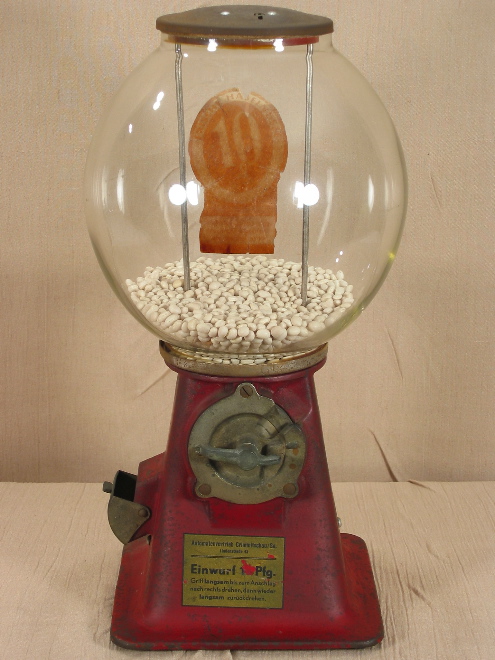___________________________________________________________________________________________
Automaten Vertrieb Crimmitshchau

___________________________________________________________________________________________

Germany; c. 1920s, 17". This is a great German machine that started trickling into the US in the late 1980s/early 1990s. It's a heavy, solid machine with a painted cast iron base, a nickel-plated steel lid, and a prominent brass mechanism. Purportedly, they were originally red and were later refurbished by the vendor in hammertone gold.
This has a counter in the base that you can see when you take the baseplate off, and shows the number of times the machine has vended. A thick string runs from the counter to the mechanism, and every time the mech turns it pulls the string which pulls the counter. I know of only one other vendor with a counter, and that's the GE coin-op fan that was made in the US during the same era this was made in Germany. I don't know what German coin this takes, but some Automatens have been converted to take an American penny or nickel---I can't remember which. I think that's blasphemous, but it's been done.
These are not common but they're not uncommon, either. I've seen another example of this model with another body decal and another type of lid, but most examples have the type of lid on the machine above and do not have a decal on the body or the globe. I think this model is underappreciated because it's foreign, but it's a great machine in its own right; solidly built, attractive, and with an unusual mechanism and unusual counter-feature. If this were an American machine it would be more highly sought after and would sell for twice as much as it does.
I've always been intrigued by these machines because of their nationality and era. Germany suffered runaway inflation in the 1920s and many people's fortunes eroded to nearly nothing because of it. The value of the coin this was designed to take may have been worth only a small fraction of its value a year after the machine was introduced, so how could anyone make a fixed-coinage vendor that would stay profitable through such a change? Did Germany keep coin sizes the same but change denominations to higher and higher values as inflation increased? I guess vendors found a way, but I don't know what it was.
This example is 100% original and has not been converted to take American money. I bought this from the American collector who first imported them into the US. It was in his collection and was the last one he owned before he sold it. I mention this because a person in that position would almost certainly keep the best one for last, suggesting that compared to other examples this one is a very good one.
___________________________________________________________________________________________
___________________________________________________________________________________________
©Small Vintage Vending 2021